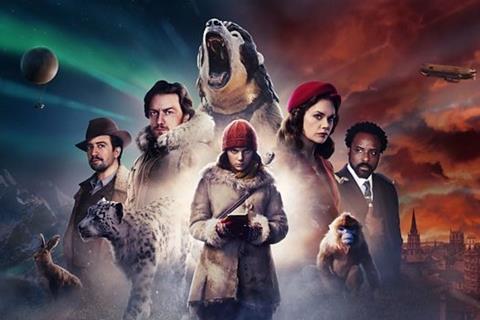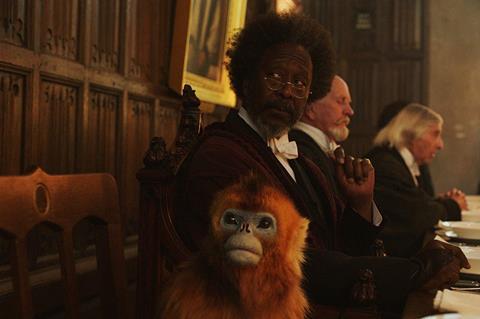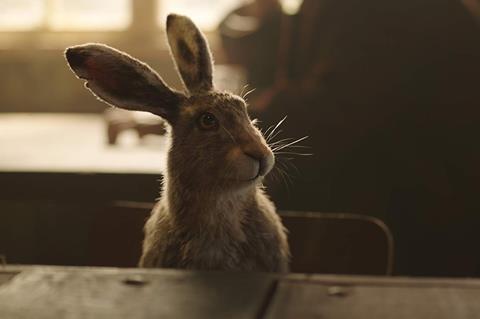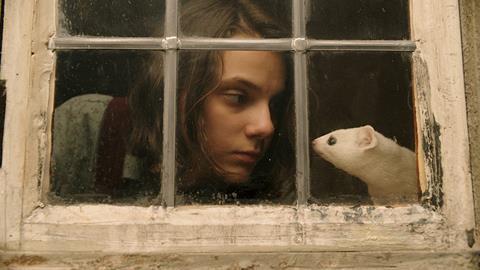Any adaptation of Philip Pullman’s multi-layered fantasy His Dark Materials must decide how to represent the cast of animalistic ‘daemons’ which feature constantly throughout the story. Adrian Pennington spoke with key members of the VFX team to find out how.

In the 2003 stage play, the creature companions were operated by black-clad puppeteers. In the 2007 feature film The Golden Compass, they were computer-generated. Their creation is also a visual effect for the new BBC and HBO series, but crucially, one based on extensive on-set puppetry.
“It’s an exciting and nerve-wracking challenge,” says visual effects supervisor, Russell Dodgson.
“Do too much to the animation and we end up ruining the drama. What makes it more complicated is that these creatures have to accent and complement the nuance of the actors because both character and daemon are embodiments of each other. Working with puppetry was priceless.”
The eight-episode series is adapted by scriptwriter Jack Thorne, produced by Bad Wolf with Warner Bros’ New Line Cinema and based on the first of the His Dark Materials books, Northern Lights. Principal actors include Dafne Keen as the heroine Lyra, James McAvoy (Lord Asriel), Ruth Wilson (the ice maiden Mrs Coulter) and Lin-Manuel Miranda (aeronaut Lee Scoresby).
Production designer Joel Collins and VFX art director and previs supervisor, Dan May (both of Painting Practice, which has worked on Black Mirror, London Has Fallen and The Hitchhiker’s Guide to the Galaxy) had conceptualised the show’s worlds and produced concept art before Framestore boarded the project just six weeks ahead of principal photography.
Having won its first VFX Oscar in 2008 for The Golden Compass, the facility was the obvious choice.
“It’s in the company’s blood,” Dodgson says. “I met with [producer] Jane Tranter and Joel and we hit it off really well. They had a deep passion for the material and strong ideas for how it should be treated from a creature perspective.
Designing daemons
He elaborates, “It was clear that this wasn’t a Doctor Dolittle-type show with cartoon animals or one with scary monsters which function as spectacle. These animals are part of the fabric of the world in which the characters exist. I don’t think anyone has attempted to do this level of character creature work in TV before. Arguably few have tried to do it in film. Placing this kind of CG character consistently alongside primary actors is really unique and not possible without keeping it all within one company.”

Of the mammoth 2050 shot order delivered by Framestore, 1000 of them were for creatures, 400 for bears with the remainder for environments and clean up.
“We have Ruth Wilson giving a really delicate performance and we have to put a monkey next to her. That can go horribly wrong.”
The first step was to work with the showrunners, actors and directors to plot the daemons’ story arcs alongside that of their corresponding human. This allowed them to clearly identify the emotional beats of each scene.
“We had lots of conversations about their energy,” Dodgson says. “The daemons are part of your soul, your free will, your curiosity. They are a reflection of emotional state, so they have to work alongside the actors, sometimes betraying the character’s thoughts.”
The VFX team went straight into rehearsals, helping to block scenes and working out the relationship between actors and their daemons.
Among decisions to be made upfront: how much screen time to devote to the daemons? how anthropomorphic should they be? And how should they appear, disappear or transform?
In the novel, a child’s daemon can change into any number of creatures but when they reach puberty it settles into one form.
“The concept works on the page because the narrative always refers to a daemon by its name even if it has changed form but on screen that wouldn’t work. There would be a visual change and the association of a daemon being the same character while in different forms would be lost.”
Lyra’s daemon is an ermine called Pantalaimon which transmutes into over 30 different kinds of creature.
“We realised that it would be very hard for an audience to fall in love with a daemon or build a relationship with it if it changed all the time so we reduced the instances of transformation to a handful and only when it made editorial sense.”
Some animals don’t transform well from one to another. Massive creatures don’t segue into tiny ones with ease.
“Huge transformations are not the point of the show. Diverting you from the story with an ugly transform would be a bigger crime than not showing it.”
“These creatures have to accent and complement the nuance of the actors because both character and daemon are embodiments of each other.” Russell Dodgson, VFX supervisor
They concluded that the transform should happen through movement and be grounded in the reality of the character’s world rather than appear magically.
Pan, for example, transforms into a bird and back again, the similar body type allowing animators to bring the bird’s wings into its body to form a silhouette of the next creature.
“We’d rather it happen off-screen than be a horrible morph on-screen,” Dodgson says. “We show it when it means something and when we can achieve it in animation.”
In order to cast the daemons for the principal actors they went to the books to see what Pullman had chosen and, in most cases, followed his lead. Then, from hundreds of photographic references, they tried to find an animal that best represented the spirit of the corresponding human character.
In the book, for example, Mrs Coulter is described as a “beautiful young lady” who is “a cess-pit of moral filth” a wicked witch in the disarming guise of a fairy godmother with a golden monkey for a daemon.
“Coulter presents herself as beautiful and meticulous in appearance with a softness to her that is alluring,” says Dodgson. “We thought the golden snub-nosed monkey was a better fit than a Tamarin Golden Lion (which was chosen in The Golden Compass). It can look cute but, much like Mrs Coulter, when it bares teeth it is truly vicious.”
Blending anthropomorphic with animalistic
In the books, the daemons are the opposite sex to their human persona, a concept to which Framestore stayed faithful (using a male hawk of the species, a female fox and so on) but finding the exact match for Mrs Coulter proved tricky.
“Neither male nor female snub-nosed monkeys felt exactly right – the male has a different, unsightly lumps of skin in the corners of their mouths while the females don’t, so we made her daemon a bit of a hybrid to find exactly what we wanted.”

Everyone was adamant that the daemons were to be naturalistic but characterful. “They are animals with a human consciousness. They are present. But how much is too much humanity?”
Framestore established an animation for the creature that was as realistic in behaviour as possible then removed some of the creature’s more primal instincts. To put it bluntly, these daemons don’t defecate.
“The trick was to spend time with real animals and study their natural instincts such as when sniffing for food or mating or hiding when scared,” Dodgson explains.
They started with anatomically accurate faces but the more human the animal is, the more they had to break the skeletal face structure.
“From a baseline of them performing very specific animalistic movements we could then add in more human awareness, and if anything felt wrong we could quickly refer back to the original naturalistic animation and correct it.”
Framestore’s team in Canada went off to film polar bears. Dodgson spent a day with a caged pine martin. Wild cats and foxes were brought on set with a trained handler, not only to reference photograph but for the actors to interact with.
Scenes featuring a real snake were shot to give the actor a better idea of how the reptile would feel and move in their hands even if most of these shots were replaced with a CG snake.
Another consideration was the inscrutability of animals and human propensity to apply emotion to their face. For that reason, Dodgson says cats and dogs are among the hardest to animate – we are simply too familiar with how we think they are thinking.
“With other animals, we have more licence to say this is how they look when sad or happy. The lack of familiarity grants us the freedom to create our own rules. Our goal was to find an extra layer of emotion in a scene and to get that across.”
Master of puppets
This VFX groundwork was dovetailed with scenes shot with actors performing with puppets. These were rudimentary rather than sophisticated animatronics but emotive nonetheless with the puppeteers playing a vital role in bringing out the best in the actor’s performance.
“Using puppets is far more than giving our animators an eyeline to work from, as critical as that is,” he says. “This was vital in giving the actors an emotional connection with their daemon through the brilliant work of the puppeteer team. When Daphne looks at Pan when she’s feeling sad, she needs to see Pan as a source of comfort.”
On set, the process would begin with a ‘puppet pass’, typically a master shot establishing where the daemons are and to give the actor’s muscle memory of its position. In progressive takes the puppets are removed, replaced just by eyeline. A further ‘clean’ pass with nothing but the set would be made, then a reference pass for lighting and colour.
Every shot was scanned with Lidar by 3D scanning specialists Clear Angle Studios, the data turned into geometry for Framestore and used for precise camera tracking and accurate lighting and shadow effects.
The puppetry process also gave Framestore “free post viz” in that they could soft matte animations into the scene directly from the rushes.
“It was great for the animators since we had detailed information about how to light for the skin and fur of the creatures and for how the creatures would navigate the space.”
Smart lenses, mostly Arri Master Primes and Ultra Primes, provided additional data about depth of field to drive the post process.
The first season was photographed on the large format sensor Arri Alexa LF with additional camera work on the Alexa Mini. Material was primarily recorded In UHD in Prores 444 converted to EXR files for VFX and colour managed with an ACES workflow through to the grade by Jean-Clément Soret at Technicolor.
Season 2, which has been shot back-to-back with the first series, has shifted to the Sony Venice camera recording native 6K to allow for more re-racking and reframing of the image in post. The ability to detach the camera body from the image sensor block for use in a ‘snorkel’ mode is also advantageous.

The large sets at Cardiff’s Wolf Studios were augmented with blue screen, including scenes of London skylines and views of Oxford from the window of an airship, and green screen of Lyra riding the bear. The more northerly the narrative gets, the more blue-screen was required, including a 360-degree blue screen shoot of the mountainous icebound archipelago Svalbard.
Framestore won the Oscar specifically for its work on Iorek Byrnison but opted for a tonally different take on the character this time.
“He’s much truer to the book,” Dodgson explains. “When we meet Iorek he is a down and out drunk in an alleyway who won’t look you in the eye. He has lost his pride so when he looks at you for the first time you feel that power. This is carried throughout the series in posture which changes from head down to more upright, his back is initially more arched and weaker before gradually getting stronger.”
The puppeteers acted dialogue with the actors on set, with their voices captured via ADR in post. The exception was Joe Tandberg, the puppeteer/actor playing heroic bear king Iorek Byrnison.
“Using a relatively unknown actor rather than star talent allowed our animators to lean into the facial performance more. The team have done such a great job. Iorek feels like a fully rounded character and we use him a lot. There are five-minute long conversation scenes with him.”
Another seven-minute sequence features Iofur (another polar bear) in conversation with Daphne. “These are full 4K single headshots. The VFX is quite unflinching.”
Framestore assigned its international teams to work on the show. London was dedicated to the monkey and the majority of Pan. Montreal took charge of the bears and later scenes of Pan. Its Indian operation was involved in comp work, tracking, roto and prep.
Most shows with this amount of VFX would have split CG characters or sequences between vendors. Dodgson says the efficiency and consistency of the achievement for His Dark Materials could not have been achieved with a division of spoils.
“It’s down to Jane and the fact that she was very open to letting us be the keeper of the daemons and the bears.”




























No comments yet